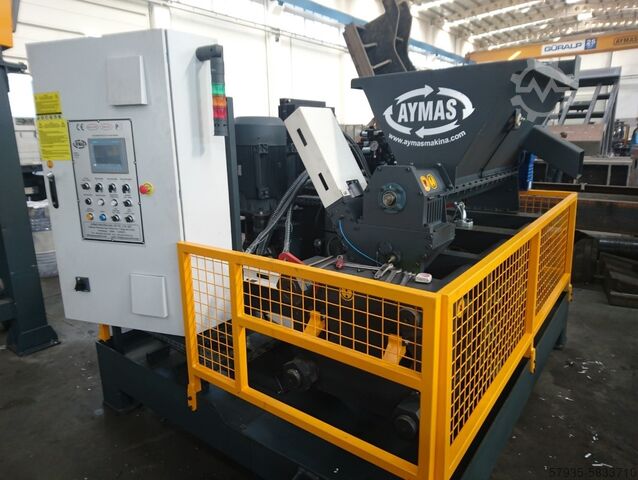Used Cable Recycling Plant for sale (8,629)
 Hengelo
Hengelo Vibration dewatering sieve VS1
AMA recycling technologiesVS1
 Kolbuszowa
Kolbuszowa Centrifuge dryer
Koltex Plastic Recycling Systems ERFOR®CR8
 Berkel en Rodenrijs
Berkel en Rodenrijs TIR cable
TIR cable

+44 20 806 810 84
 Merishausen
Merishausen Ballshaping- and Delaminationmill
RW Recycling World GmbHMolinator RW VKR
 Toruń
Toruń Quad Shaft Shredder
ZŁOMIARZE Recycling TechnologyShredder MCW 52/MCW 76
Discover more used machines
 Astana
Astana Stationary concrete mixing plant
PROMAX Concrete PlantS130-TWN (130m3/h)
 HALİLBEYLİ OSB MAH, İzmir Ankara Cd. NO:5, 35743 Kemalpaşa/İzmir, Türkiye
HALİLBEYLİ OSB MAH, İzmir Ankara Cd. NO:5, 35743 Kemalpaşa/İzmir, Türkiye Two shaft shredder
Aymas Recycling MachinerySH 90
 Kolbuszowa
Kolbuszowa Dynamic Washer for plastic waste
Koltex Plastic Recycling SystemsDR8
 Toruń
Toruń Turbo Shredder MTR-800
Scrappers Recycling TechnologyMTR-800
 HALİLBEYLİ OSB MAH, İzmir Ankara Cd. NO:5, 35743 Kemalpaşa/İzmir, Türkiye
HALİLBEYLİ OSB MAH, İzmir Ankara Cd. NO:5, 35743 Kemalpaşa/İzmir, Türkiye Scrap baler
Aymas Recycling MachineryCP (50x30) Used Beverage Can Baler
 Kolbuszowa
Kolbuszowa Washing and Peletizing Line for plastic
Koltex Plastic Recycling Systems
 HALİLBEYLİ OSB MAH, İzmir Ankara Cd. NO:5, 35743 Kemalpaşa/İzmir, Türkiye
HALİLBEYLİ OSB MAH, İzmir Ankara Cd. NO:5, 35743 Kemalpaşa/İzmir, Türkiye Single shaft shredder
Aymas Recycling MachineryTSG 360
 BAYOSB Halilbeyli OSB Mah. Sanayi Cad. no:11, Halilbeyli, 35743 Kemalpaşa/İzmir, Turkey
BAYOSB Halilbeyli OSB Mah. Sanayi Cad. no:11, Halilbeyli, 35743 Kemalpaşa/İzmir, Turkey Scrap shear
Aymas Recycling MachinerySB 700 T Shear Baler
 BAYOSB Halilbeyli OSB Mah. Sanayi Cad. no:11, Halilbeyli, 35743 Kemalpaşa/İzmir, Turkey
BAYOSB Halilbeyli OSB Mah. Sanayi Cad. no:11, Halilbeyli, 35743 Kemalpaşa/İzmir, Turkey Scrap baler
Aymas Recycling MachineryHP3 (40x40) Baling Press
 BAYOSB Halilbeyli OSB Mah. Sanayi Cad. no:11, Halilbeyli, 35743 Kemalpaşa/İzmir, Turkey
BAYOSB Halilbeyli OSB Mah. Sanayi Cad. no:11, Halilbeyli, 35743 Kemalpaşa/İzmir, Turkey Two shaft shredder
Aymas Recycling MachinerySH 360 Double Shaft Shredder
 BAYOSB Halilbeyli OSB Mah. Sanayi Cad. no:11, Halilbeyli, 35743 Kemalpaşa/İzmir, Turkey
BAYOSB Halilbeyli OSB Mah. Sanayi Cad. no:11, Halilbeyli, 35743 Kemalpaşa/İzmir, Turkey Scrap shear
Aymas Recycling MachineryIS 1600 Inclined Shear
 BAYOSB Halilbeyli OSB Mah. Sanayi Cad. no:11, Halilbeyli, 35743 Kemalpaşa/İzmir, Turkey
BAYOSB Halilbeyli OSB Mah. Sanayi Cad. no:11, Halilbeyli, 35743 Kemalpaşa/İzmir, Turkey Scrap baler
Aymas Recycling MachineryHP3 (50x50) Baling Press
 BAYOSB Halilbeyli OSB Mah. Sanayi Cad. no:11, Halilbeyli, 35743 Kemalpaşa/İzmir, Turkey
BAYOSB Halilbeyli OSB Mah. Sanayi Cad. no:11, Halilbeyli, 35743 Kemalpaşa/İzmir, Turkey Briquetting press
Aymas Recycling MachineryBP 80 Chip Briquetting Press
 BAYOSB Halilbeyli OSB Mah. Sanayi Cad. no:11, Halilbeyli, 35743 Kemalpaşa/İzmir, Turkey
BAYOSB Halilbeyli OSB Mah. Sanayi Cad. no:11, Halilbeyli, 35743 Kemalpaşa/İzmir, Turkey Scrap shear
Aymas Recycling MachineryIS 1350 Inclined Shear
 BAYOSB Halilbeyli OSB Mah. Sanayi Cad. no:11, Halilbeyli, 35743 Kemalpaşa/İzmir, Turkey
BAYOSB Halilbeyli OSB Mah. Sanayi Cad. no:11, Halilbeyli, 35743 Kemalpaşa/İzmir, Turkey Briquetting press
Aymas Recycling MachineryBP 160 Chip Briquetting Press
 BAYOSB Halilbeyli OSB Mah. Sanayi Cad. no:11, Halilbeyli, 35743 Kemalpaşa/İzmir, Turkey
BAYOSB Halilbeyli OSB Mah. Sanayi Cad. no:11, Halilbeyli, 35743 Kemalpaşa/İzmir, Turkey Briquetting press
Aymas Recycling MachineryBP 200 Chip Briquetting Press
 BAYOSB Halilbeyli OSB Mah. Sanayi Cad. no:11, Halilbeyli, 35743 Kemalpaşa/İzmir, Turkey
BAYOSB Halilbeyli OSB Mah. Sanayi Cad. no:11, Halilbeyli, 35743 Kemalpaşa/İzmir, Turkey Scrap baler
Aymas Recycling MachineryHP3-C (40x40) Continuous Baling Press
 BAYOSB Halilbeyli OSB Mah. Sanayi Cad. no:11, Halilbeyli, 35743 Kemalpaşa/İzmir, Turkey
BAYOSB Halilbeyli OSB Mah. Sanayi Cad. no:11, Halilbeyli, 35743 Kemalpaşa/İzmir, Turkey Scrap Shear
Aymas Recycling MachineryIS 1100 Inclined Shear
 BAYOSB Halilbeyli OSB Mah. Sanayi Cad. no:11, Halilbeyli, 35743 Kemalpaşa/İzmir, Turkey
BAYOSB Halilbeyli OSB Mah. Sanayi Cad. no:11, Halilbeyli, 35743 Kemalpaşa/İzmir, Turkey Scrap shear
Aymas Recycling MachineryIS 700 Inclined Shear
 BAYOSB Halilbeyli OSB Mah. Sanayi Cad. no:11, Halilbeyli, 35743 Kemalpaşa/İzmir, Turkey
BAYOSB Halilbeyli OSB Mah. Sanayi Cad. no:11, Halilbeyli, 35743 Kemalpaşa/İzmir, Turkey Scrap shear
Aymas Recycling MachineryIS 900 Inclined Shear
Used Cable Recycling Plant (8,629)
Search Machineseeker now with more than 200,000 used machines:Browse through the most popular machine descriptions:
This may be of interest to you

+44 20 806 810 84






































































































































